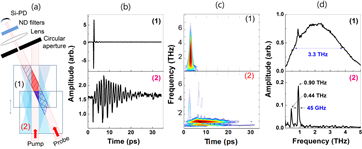Byungwoo Son
테라헤르츠파(테라파) 발생 및 이를 이용한 물질 분석(분광, 시분해 분광, 이미징) 연구를 수행중이다. 테라파는 광파의 분광특성과 전자파의 투과특성을 모두 가지고 있어, 패키징이 되어 있는 물질 구성 및 구조 분석에 용이한 장점이 있다. 또한, 빛에너지가 낮은 수준이어서 인체에 무해한 특성을 보여, X-ray 대체 광원으로도 그 쓰임이 높아지고 있다. 그에 따라, 공항검색대, 폭발물 및 불법 마약 탐색, 비파괴 검사, 암세포 진단, 선박 페인트 두께 측정, 전기기판의 회로도 검사, 가스 센싱 등 많은 산업적 분야에서 필수 광원으로 쓰임이 높아지고 있다.
극초단 펄스파(펨토초 레이저 펄스)와 준위상정합 구조의 비선형 광학물질(lithium niobate, lithium tantalate 등)을 이용하여 파장가변이 쉬운 테라파를 개발하였다. 고출력 테라파 개발 및 다양한 모양의 테라파를 발생 및 비교분석 하였다. 또한, 물질내에서 발생과 동시에 테라파를 검출하는 시스템을 개발하였고, 테라파 발생특성 분석에 기여하였다. 이어서, 고분해능 분광 및 영상, 테라파 펌프-프로브 실험 등을 진행 중이다. 다양한 모양을 가진 테라파를 발생하여, 태양전지소자 및 양자우물 등의 폴리머와 반도체 물질 등의 광 특성을 분석중이다.

THz radiation refers to electromagnetic waves typically with 0.1 ~ 10 THz frequencies, corresponding to a range between the high-frequency edge of microwave bands and the long-wavelength edge of far-infrared rays. In terms of wavelength, 1 THz, corresponding to 1012 Hz or 1000 GHz, represents 0.3 mm or 300 ㎛ in free space. The electromagnetic energy of THz radiation with 1 THz frequency is 4.1 meV, corresponding to bio-molecular vibration and rotation energy bands. Thus, such THz energy bands are effective for bio-imaging applications. However, due to strong absorption into water, the earth atmosphere unfortunately act as a strong THz radiation absorber, causing quite short propagating ranges and communicational limitations. Since THz generation and detection schemes have been developed in the mid-1980s, researchers have actively investigated THz radiation, properties and applications.
THz radiation possesses advantages of two bands. Like electronic waves, THz has ability to penetrate effectively non-conducting materials: paper, wood, plastic, clothing, etc. Moreover, like light waves, THz easily propagates through space and is reflected, refracted and focused. Thus, it is powerful for spectroscopy and bio-molecule imaging applications with such properties and energy band. Further, researchers utilize and develop THz radiation schemes in communication, inspection, diagnostics, etc.
We have studied on THz wave generation at QPM crystals with fs laser pulses. THz waves are generated via nonlinear optical phenomena. A QPM crystal emit THz radiation via DFG when an ultra-short optical pulse irradiates crystals. The QPM condition in DFG is,
Thus, THz waves depend on QPM materials and structures. As a result of periodically poled structures, emitted THz pulses form multi-cycle shape and hold narrow spectral bandwidth.

For experiment, we utilized photoconductive antenna with 5 ㎛ dipole gap as THz wave detector. In addition, we performed low-temperature experiment with liquid N2-cryogenic vacuum chamber to reduce signal absorption in crystals.
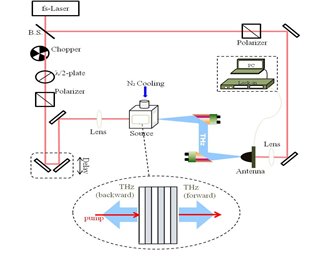
As a result, we successively generated multi-cycle (corresponding to QPM structure) narrowband (around 30~40 GHz, up to 20 GHz) THz waves and studied tuning characteristics depending on temperature and grating period of QPM crystals.
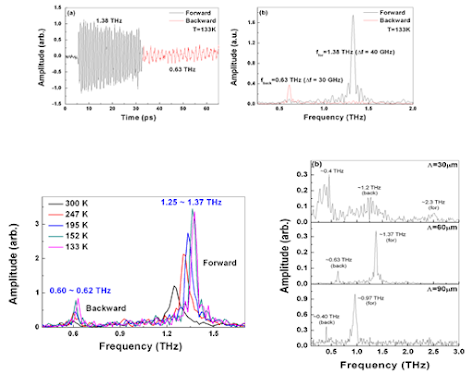
Futhermore, via time-frequency spectrogram based on Morlet wavelet basis, we effectively analyzed THz wave characteristics such
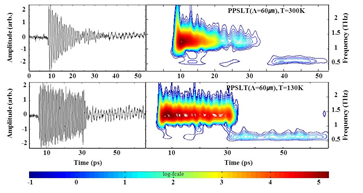

We have developed easily tunable THz generation system using the QPM crystals with fanned-out grating structures. As shown above, the radiated THz frequencies are dominantly determined by grating periods of QPM structures. Using the dependence in the structures, we designed fanned-out periodically poled structures which have linearly varying grating periods, as shown in the above figure. Based on the varying periods, the THz pulse tuning in the frequency and bandwidth domains was demonstrated. Such a tunable narrowband THz pulse could be the best candidate for the light source in high-resolution spectroscopy and imaging, THz-pump and optical/THz-probe experiment, etc.
For the perfect phase-matching in which condition the output THz power is the highest, we adopted the tilted pulse-front pumping (TPFP) scheme, resulting in high-power THz generation. In nature, the velocities of fundamental (800 nm or 375 THz) and generated (300 ㎛ or 1 THz) waves are difference due to the strong dispersion of nonlinear optical media. Thus, the phase-matching between the two waves should be accomplished by external techniques such as birefringence (BPM), QPM, and TPFP. Among them, BPM and TPFP methods are based on perfect phase-matching. In THz fields, TPFP methods are prominent owing to the higher conversion efficiency. We have also demonstrated the TPFP scheme and obtained the single-cycle high-power THz pulse. We compared it with the other schemes such as non phase-matching and QPM as well, as shown in the following figure.
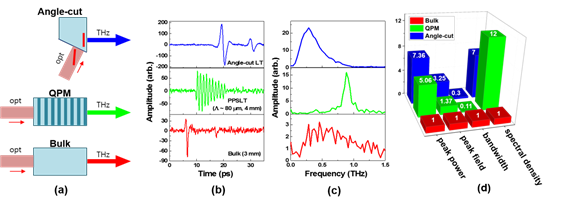
We have developed and chracterized the novel THz detection scheme. In the scheme, we use not specific and complicated detection methods but normal and simple elements. The generated THz waves are simultaneously detected at a same THz source sample via nonlinear optical parametric process with a general silicon-photodiode.
